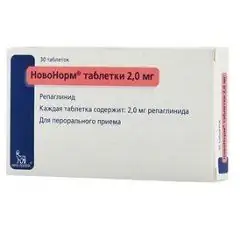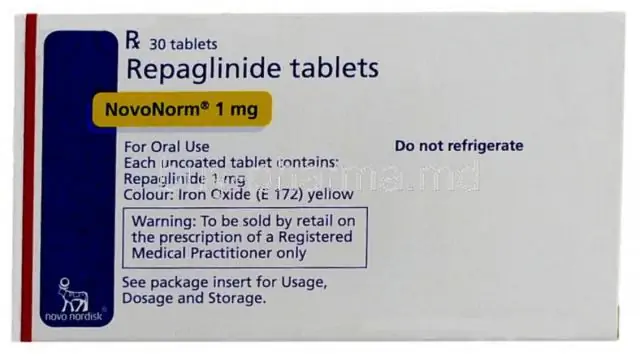- Author Rachel Wainwright [email protected].
- Public 2023-12-15 07:39.
- Last modified 2025-11-02 20:14.
NovoNorm
NovoNorm: instructions for use and reviews
- 1. Release form and composition
- 2. Pharmacological properties
- 3. Indications for use
- 4. Contraindications
- 5. Method of application and dosage
- 6. Side effects
- 7. Overdose
- 8. Special instructions
- 9. Application during pregnancy and lactation
- 10. Use in childhood
- 11. In case of impaired renal function
- 12. For violations of liver function
- 13. Use in the elderly
- 14. Drug interactions
- 15. Analogs
- 16. Terms and conditions of storage
- 17. Terms of dispensing from pharmacies
- 18. Reviews
- 19. Price in pharmacies
Latin name: NovoNorm
ATX code: A10BX02
Active ingredient: repaglinide (Repaglinide)
Manufacturer: Boehringer Ingelheim Pharma (Germany); Novo Nordisk, A / S (Denmark)
Description and photo update: 09.10.2019

NovoNorm is a hypoglycemic drug for oral administration.
Release form and composition
NovoNorm is available in the form of tablets of various dosages:
- 0.5 mg tablets: biconvex, round, white, on one side marked with the Company symbol (bull Apis);
- tablets 1 mg: biconvex, round, yellow, on one side marked with the symbol of the Company (bull Apis);
- 2 mg tablets: biconvex, round, brownish-pink in color, marked on one side with the symbol of the Company (bull Apis).
All tablets, regardless of dosage, are packed in blisters of 15 pcs. In a cardboard box 2 or 6 blisters and instructions for the use of NovoNorm.
Composition for 1 tablet:
- active substance: repaglinide - 0.5; 1 or 2 mg;
- auxiliary components: povidone, corn starch, calcium hydrogen phosphate anhydrous, glycerin 85%, poloxamer 188, meglumine, microcrystalline cellulose, potassium polyacrylate, magnesium stearate, yellow iron oxide (for 1 mg tablets) and red iron oxide (for 2 mg tablets).
Pharmacological properties
Pharmacodynamics
NovoNorm refers to short-acting oral hypoglycemic agents. By stimulating the secretion of insulin by the pancreas, it rapidly lowers blood glucose levels. Repaglinide binds to a specific receptor protein on the β-cell membrane, which leads to depolarization of the cell membrane and blocking of ATP-dependent potassium channels, and this, in turn, causes the opening of calcium channels. Due to the influx of calcium into the β-cells of the pancreas, insulin secretion is stimulated.
In patients with type 2 diabetes mellitus, the reaction to the drug is manifested within 30 minutes after taking the pill, which ensures a decrease in blood sugar levels throughout the meal. The plasma concentration of repaglinide rapidly decreases and already 4 hours after taking NovoNorm in the plasma of patients with non-insulin dependent diabetes mellitus type 2, a low content of the drug is found.
When doses in the range of 0.5-4 mg are prescribed, a dose-dependent decrease in glucose concentration is observed in the blood of patients. According to the results of clinical studies, it was revealed that NovoNorm should be taken before meals.
Pharmacokinetics
The absorption of repaglinide is fast. The maximum plasma concentration is achieved within 1 hour after taking the drug, and then its plasma content decreases rapidly.
There were no clinically significant differences in the pharmacokinetics of NovoNorm when taken on an empty stomach, 15 minutes before meals, 30 minutes before meals or immediately before meals.
The pharmacokinetics of the drug is characterized by an average absolute bioavailability of 63%. Clinical studies have shown a high (about 60%) interindividual variability in the plasma concentration of repaglinide. The within-species variability averages 35% (ranging from low to moderate). Since the selection of the dose of NovoNorm is carried out depending on the response to the treatment, interindividual variability does not affect the effectiveness of therapy in any way.
The volume of distribution of repaglinide is low (30 L), and the connection with plasma proteins is high (more than 98%). The half-life is about 1 hour. The drug is completely excreted from the body in 4-6 hours. Repaglinide metabolism is complete, it is carried out mainly by the isoenzyme CYP2C8 and to some extent by CYP3A4. The resulting metabolites have no significant hypoglycemic effect.
The main route of elimination of the drug is through the intestine (most of the repaglinide is excreted in the form of metabolites and less than 2% - unchanged). About 8% of the dose taken is found in the form of metabolites in the urine.
In renal failure of mild and moderate severity, the values of the maximum plasma concentration and AUC (area under the concentration-time curve) are almost the same as in patients with normal renal function. In severe renal impairment, C max increased by approximately 1.5 times, and AUC - 2 times. However, in the studies conducted, only a weak correlation was found between creatinine clearance and the concentration of repaglinide in plasma. In patients with impaired renal function, NovoNorm is used in usual initial doses, but a subsequent increase in the dose, especially in severe renal impairment requiring hemodialysis, is carried out with caution.
In persons with chronic liver diseases (moderate and severe), the maximum plasma concentration of repaglinide increases more than 2 times, and AUC - more than 3.5 times. No differences in glucose concentration were found. In patients with impaired liver function, NovoNorm is used with caution, increasing the intervals between dose increases (for a more accurate assessment of the response to therapy).
In animal studies, it was shown that repaglinide does not have teratogenicity, however, in embryos and newborn rat pups born to females who received high doses of the drug in the last third of pregnancy and during lactation, anomalies of limb development that did not have a teratogenic nature were revealed. Repaglinide is secreted in breast milk.
Indications for use
NovoNorm is used for type 2 diabetes mellitus in case of ineffectiveness of non-drug treatment methods (physical activity, weight loss, diet therapy).
It is possible to use NovoNorm in combination therapy with metformin and thiazolidinediones. The joint administration of several antidiabetic agents is indicated in cases where monotherapy with thiazolidinediones, metformin or repaglinide does not give satisfactory glycemic control.
Contraindications
Absolute:
- type 1 diabetes mellitus;
- severe liver dysfunction;
- diabetic precoma and coma;
- diabetic ketoacidosis;
- infectious diseases;
- conditions requiring insulin therapy (including major surgical interventions);
- simultaneous reception of gemfibrozil;
- co-administration with inducers of the CYP3A4 isoenzyme (phenytoin, rifampicin, etc.);
- the period of pregnancy and breastfeeding;
- children and adolescents up to 18 years old;
- advanced age over 75;
- hypersensitivity to the main or any of the auxiliary components of the hypoglycemic agent.
Relative (NovoNorm tablets are used with caution): mild and moderate liver dysfunction, chronic renal failure, febrile syndrome, alcoholism, malnutrition, general serious condition.
NovoNorm, instructions for use: method and dosage
NovoNorm tablets are intended for oral administration. Their intake should be timed to coincide with meals.
The drug is prescribed to lower blood glucose levels in addition to physical activity and diet. The drug is taken 2, 3 or 4 times a day (before the main meals). It is recommended to take NovoNorm 0-30 minutes before meals (optimally, 15 minutes before meals). Patients skipping meals or, conversely, receiving additional meals should be instructed to skip or take additional repaglinide, respectively.
The dose selection is carried out individually. Control of glucose levels in blood and / or urine is carried out not only by the patient himself, but also by the doctor (periodically), who sets the minimum effective dose of NovoNorm for a particular patient. The content of glycosylated hemoglobin is also an indicator of response to treatment. Periodic monitoring of blood glucose levels is necessary to detect in the patient primary resistance (inadequate decrease in blood sugar upon the first administration of the drug at the maximum recommended dose) and secondary resistance (weakening of the hypoglycemic response to therapy after previously effective treatment).
In patients with type 2 diabetes mellitus, blood sugar levels are usually well controlled by diet, therefore, during a period of temporary loss of glycemic control in such patients, a short course of treatment with repaglinide is usually sufficient.
The initial dose of NovoNorm is determined by the doctor. For patients who have never previously received oral hypoglycemic agents, the drug is prescribed in an initial single dose of 0.5 mg. Then, once a week or once every 2 weeks, the dose is adjusted (the main reference point for the response to the treatment is the blood glucose level). For patients who switch to repaglinide from another oral hypoglycemic agent, the initial single dose is 1 mg (transfer from one drug to another can be done immediately).
The maximum single dose is 4 mg, and the daily dose is no more than 16 mg.
When NovoNorm is used in combination therapy with thiazolidinediones or metformin, its initial dose does not differ from that of monotherapy. Then the doses of the drugs used are adjusted, taking into account the achieved blood glucose level.
Side effects
- gastrointestinal tract: often - loose stools, abdominal pain; very rarely - constipation, vomiting; frequency unknown - nausea;
- hepatobiliary system: very rarely - liver dysfunction, increased activity of liver enzymes (usually insignificant and transient);
- metabolism and nutrition: often - hypoglycemia (manifested by dizziness, hunger, anxiety, tremors, difficulty concentrating and increased sweating); frequency unknown - hypoglycemia with loss of consciousness, hypoglycemic coma;
- sense organs: very rarely - transient visual disturbances (especially at the beginning of therapy);
- skin and subcutaneous fat: frequency unknown - itching, skin redness, urticaria, rash;
- immune system: very rarely - allergic reactions (for example, vasculitis, anaphylactic reactions).
Overdose
In case of an overdose of NovoNorm, an excessive decrease in blood glucose levels and the appearance of signs of hypoglycemia (headache, dizziness, tremors, increased sweating, etc.) are possible.
If these symptoms occur, appropriate measures should be taken to increase blood glucose (take carbohydrate-rich foods or dextrose). If hypoglycemia is associated with loss of consciousness and coma, intravenous dextrose is recommended.
special instructions
The risk of hypoglycemia with the use of repaglinide increases in the case of taking NovoNorm in combination therapy with other oral hypoglycemic agents.
Deterioration of glycemic control in patients with achieved stabilization of the state can occur under the influence of stress factors (trauma, surgery, fever, infection). In such situations, it may be necessary to cancel NovoNorm and temporary administration of insulin.
In many patients, the effect of lowering plasma glucose from oral hypoglycemic agents diminishes over time. The reason is both the weakening of the response to the drug (the so-called secondary resistance) and the progression of the disease itself. Secondary resistance must be distinguished from primary resistance, when NovoNorm is ineffective already at the first application.
In malnourished and malnourished patients, caution should be exercised in the selection of the initial and maintenance doses to avoid hypoglycemia.
Influence on the ability to drive vehicles and complex mechanisms
Patients should be warned about the possible development of hypoglycemia during treatment with NovoNorm. While driving vehicles or other mechanisms, it is required to take the necessary measures to prevent this condition (this is especially important for those people who have no or mild precursor symptoms of hypoglycemia, as well as for patients with frequent episodes of hypoglycemia). Before starting such work, you should evaluate the feasibility of such activities directly during the treatment period.
Application during pregnancy and lactation
There are no data on the safety of repaglinide in pregnant and lactating women, therefore, the use of NovoNorm is not recommended during pregnancy and breastfeeding.
Pediatric use
NovoNorm is not prescribed for children and adolescents under 18 years of age, since no clinical studies of repaglinide have been conducted in this age group.
With impaired renal function
In patients with severely impaired renal function, NovoNorm dose selection is performed with extreme caution.
For violations of liver function
NovoNorm is contraindicated in persons with severely impaired liver function.
For mild to moderate hepatic dysfunction, the drug is prescribed with caution.
Use in the elderly
In elderly patients over the age of 75 years, clinical studies of repaglinide have not been carried out (NovoNorm is not recommended for use).
Drug interactions
Non-selective beta-blockers, salicylates, anabolic steroids, monoamine oxidase inhibitors, nonsteroidal anti-inflammatory drugs, angiotensin-converting enzyme inhibitors, ethanol and octreotide can enhance the hypoglycemic effect of NovoNorm.
Thiazide diuretics, thyroid hormones, oral hormonal contraceptives, glucocorticosteroids, sympathomimetics and danazol are able to reduce the hypoglycemic effect of NovoNorm (when used simultaneously with the listed drugs, it is necessary to carefully monitor the blood glucose level).
There is a potential for a potential interaction between repaglinide and drugs excreted primarily in the bile.
Inhibitors of the CYP3A4 isoenzyme (erythromycin, mibefradil, ketoconazole, fluconazole, itraconazole) can slow down the metabolism of the drug, increasing its plasma concentration, and inducers of the CYP3A4 isoenzyme (phenytoin, rifampicin, etc.) - accelerate the concentration of metabolism, reducing isoenzyme CYP3A4 is contraindicated).
Analogs
The analogues of NovoNorm are Astrozone, Amalvia, Glykambi, Diaglinid, Jardins, Iglinid, Invokana, Pioglar, Pioglit, Forsiga, etc.
Terms and conditions of storage
Keep out of the reach of children. Store in a dry place at a temperature of + 15 … + 25 ° C.
The shelf life of the tablets is 5 years.
Terms of dispensing from pharmacies
Dispensed by prescription.
Reviews about NovoNorm
There are not so many reviews about NovoNorm, but almost all of them are positive. The drug is good at lowering blood sugar levels and is an excellent addition to the diet. Repaglinide is excreted mainly through the intestines, therefore it has almost no effect on kidney function, which is very important for patients with diabetes mellitus. The cost of the drug is low.
Price for NovoNorm in pharmacies
The price of NovoNorm depends on the dosage of tablets and 30 pcs per pack. is:
- tablets 0.5 mg - 90-130 rubles;
- tablets 1 mg - 100-190 rubles;
- tablets 2 mg - 170-210 rubles.

Maria Kulkes Medical journalist About the author
Education: First Moscow State Medical University named after I. M. Sechenov, specialty "General Medicine".
Information about the drug is generalized, provided for informational purposes only and does not replace the official instructions. Self-medication is hazardous to health!






